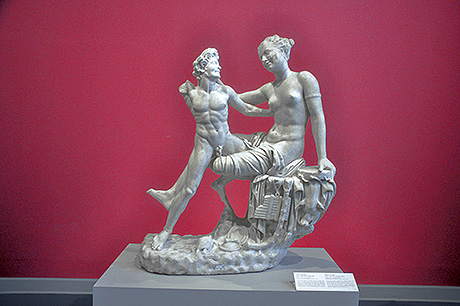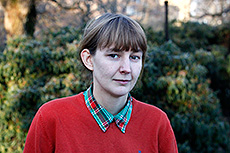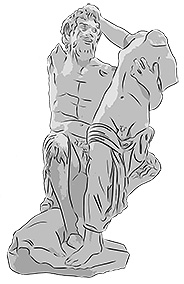 Hermaphroditus and satyr, Berlin, Antikensammlung. Photo: John Robb.
Hermaphroditus and satyr, Berlin, Antikensammlung. Photo: John Robb.
The view that androgynous individuals are pathologically deviant has caused scholars to reject the possibility that the mythological figure Hermaphroditus could be perceived as erotically attractive. But the Romans had a different view of sexuality and a new doctoral thesis from the University of Gothenburg shows that Hermaphroditus was an object of in particular men’s desire.
In Greek mythology, the goddess of love and desire, Afrodite, had an androgynous child, Hermaphroditus, together with the messenger of the gods, Hermes. In her doctoral thesis, Linnea Åshede explores how Hermaphroditus is represented in Roman art, or more precisely in group scenes depicted in for example frescos and sculptures, which illustrates how the Romans thought people with dual sexual characteristics should relate to and be approached by women, men, human-like figures and animal-like satyrs.
‘Hermaphroditus and the creatures in the group scenes, for example Pan, maenads, gods and erotes, reflect through their specific construction in the imagery how contemporary cultures thought of certain boundaries, for example what was considered acceptable behaviour for more or less feminine or masculine bodies,’ says Åshede.
Reflects the Roman view of sexuality
The most important result of the study is that Hermaphroditus is not portrayed as half woman, half man – the figure should instead be understood as an amalgamation of the beauty of women and erotically objectified boys. Thus, Hermaphroditus reflects the Roman view of sexuality, which differs from the modern, strictly gender-based division into homoerotic and heteroerotic desire.
Instead there was a division into adult men as actively desiring and women and boys as passive objects. Hermaphroditus is portrayed almost completely without conventional masculine traits, and thus appears as ‘the best of two worlds’ as an object of male desire.
 ‘Contrary to the predominant modern view of atypically sexed individuals as pathological deviations, Hermaphroditus is depicted as an attractive, idealised and positive figure. It is however important to distinguish between Hermaphroditus as a mythological figure and real atypically sexed people, who during Antiquity were often considered problematic and therefore treated badly.’
‘Contrary to the predominant modern view of atypically sexed individuals as pathological deviations, Hermaphroditus is depicted as an attractive, idealised and positive figure. It is however important to distinguish between Hermaphroditus as a mythological figure and real atypically sexed people, who during Antiquity were often considered problematic and therefore treated badly.’
Åshede’s study also shows that previous research on Hermaphroditus has been influenced by contemporary conceptions of sexuality and gender, which do not harmonise with the Roman views. Modern expectations that hermaphrodites always must be perceived as shocking or deformed have led previous research to consider the male figures’ erotic attraction to Hermaphroditus as mere ‘mistakes’.
‘Scholars claiming that male figures who undress Hermaphroditus were really looking for a woman have unintentionally reproduced transphobic stereotypes where individuals with unusual gender expressions are considered to be sneaky frauds,’ she says.
May have served as a ‘safety valve’
 The thesis shows that Hermaphroditus is generally well accepted as long as he/she complies with the rules for how a ‘passive’ woman/boy is expected to behave, but is met with resistance if he/she takes too much ‘masculine’ initiative. It seems as if the Romans thought that all beings – women, men, gods, people and animals – felt the same kind of desire, but that only certain groups were allowed to act on their impulses. There are exceptions, however, where Hermaphroditus displays traditionally masculine behaviour and desire without meeting any resistance.
The thesis shows that Hermaphroditus is generally well accepted as long as he/she complies with the rules for how a ‘passive’ woman/boy is expected to behave, but is met with resistance if he/she takes too much ‘masculine’ initiative. It seems as if the Romans thought that all beings – women, men, gods, people and animals – felt the same kind of desire, but that only certain groups were allowed to act on their impulses. There are exceptions, however, where Hermaphroditus displays traditionally masculine behaviour and desire without meeting any resistance.
‘So what’s most unique about Hermaphroditus is not the dual sexual characteristics, but that the figure can be represented in art as being simultaneously desiring and desirable – as truly transgressing conventional gender roles.’
The group scenes portraying Hermaphroditus do not depict complete events with a given outcome, but rather ‘crystallised moments’ consisting of various intentional ambiguities, aimed to engage the viewer’s imagination and provide opportunities for interpretation and speculation.
‘It’s possible that Hermaphroditus served as a ”safety valve” in relation to society’s norms, meaning that the figure provided space for fantasies about alternatives to the rigid gender roles,’ says Åshede.
More information:
Linnea Åshede, tel.: +46 (0)31 786 52 62, email: linnea.ashede@gu.se
Title of the doctoral thesis: Desiring Hermaphrodites: The Relationships of Hermaphroditus in Roman Group Scenes
Date, time and venue of the public defence: Friday 27 November 2015 at 1 pm, Faculty of Arts, Renströmsgatan 6, Gothenburg
External reviewer: Caroline Vout, Cambridge University
The thesis can be ordered from Linnea Åshede, email: linnea.ashede@gmail.com
Thesis summary: http://hdl.handle.net/2077/40657

 ‘Contrary to the predominant modern view of atypically sexed individuals as pathological deviations, Hermaphroditus is depicted as an attractive, idealised and positive figure. It is however important to distinguish between Hermaphroditus as a mythological figure and real atypically sexed people, who during Antiquity were often considered problematic and therefore treated badly.’
‘Contrary to the predominant modern view of atypically sexed individuals as pathological deviations, Hermaphroditus is depicted as an attractive, idealised and positive figure. It is however important to distinguish between Hermaphroditus as a mythological figure and real atypically sexed people, who during Antiquity were often considered problematic and therefore treated badly.’ The thesis shows that Hermaphroditus is generally well accepted as long as he/she complies with the rules for how a ‘passive’ woman/boy is expected to behave, but is met with resistance if he/she takes too much ‘masculine’ initiative. It seems as if the Romans thought that all beings – women, men, gods, people and animals – felt the same kind of desire, but that only certain groups were allowed to act on their impulses. There are exceptions, however, where Hermaphroditus displays traditionally masculine behaviour and desire without meeting any resistance.
The thesis shows that Hermaphroditus is generally well accepted as long as he/she complies with the rules for how a ‘passive’ woman/boy is expected to behave, but is met with resistance if he/she takes too much ‘masculine’ initiative. It seems as if the Romans thought that all beings – women, men, gods, people and animals – felt the same kind of desire, but that only certain groups were allowed to act on their impulses. There are exceptions, however, where Hermaphroditus displays traditionally masculine behaviour and desire without meeting any resistance.